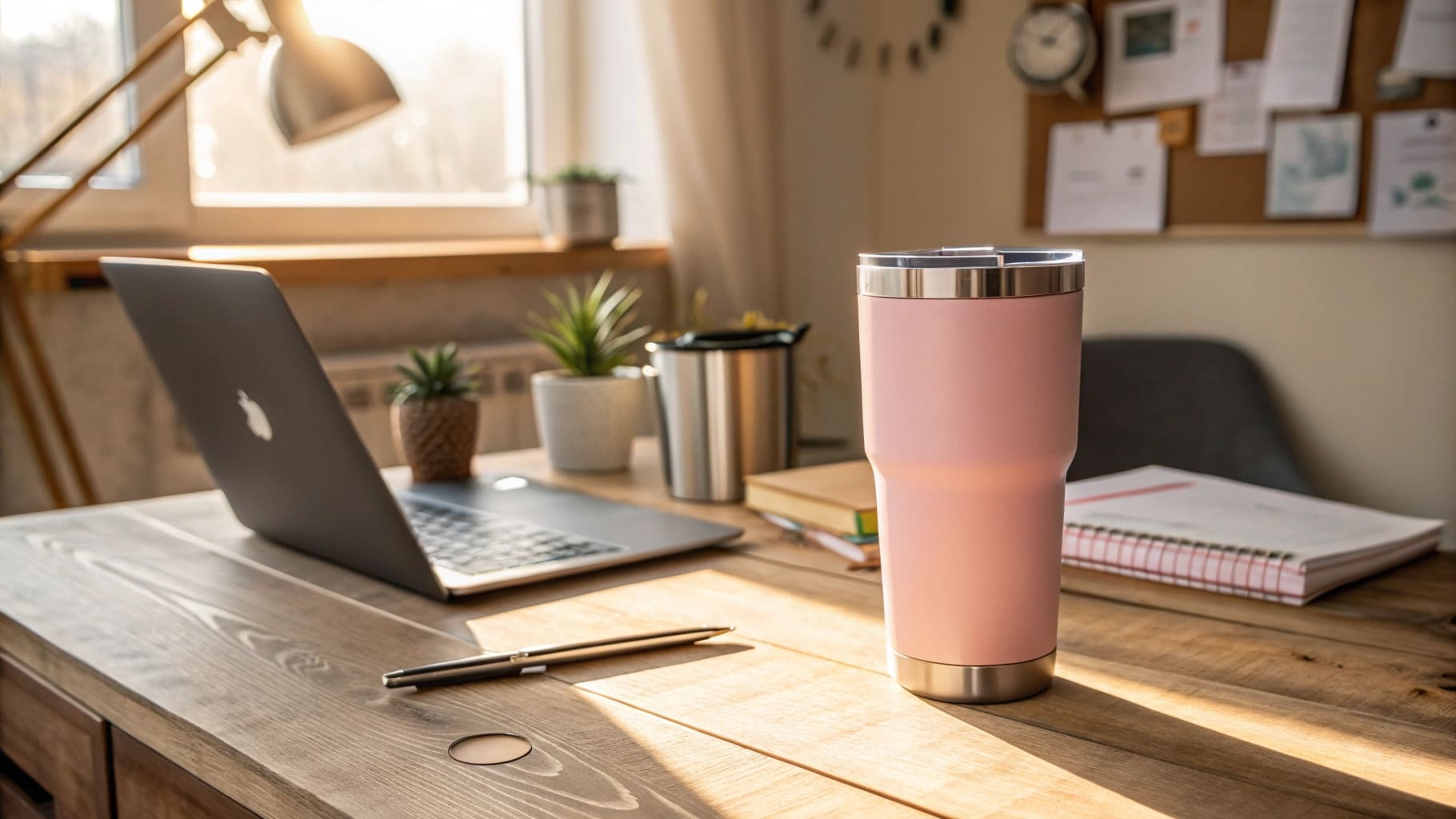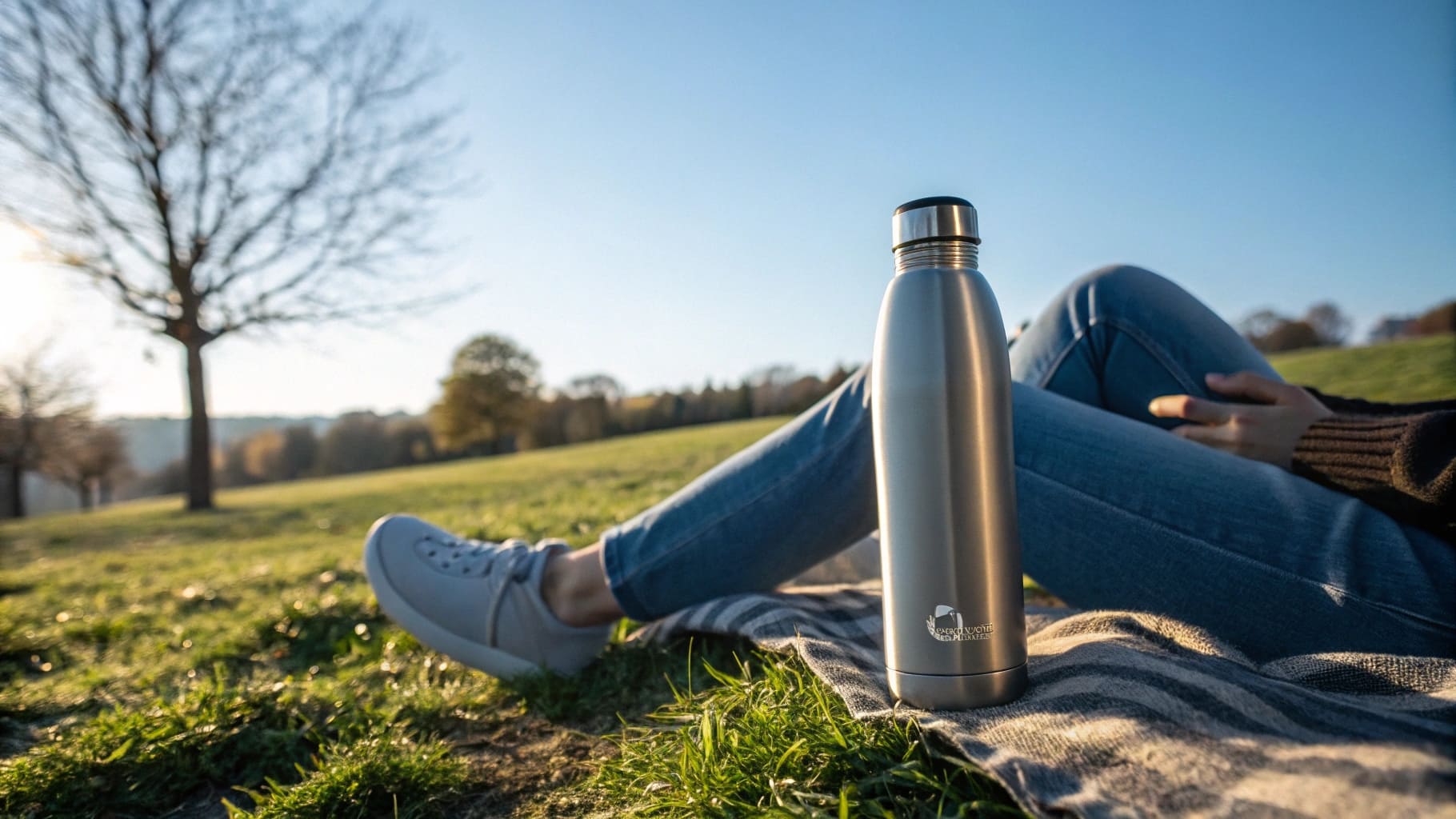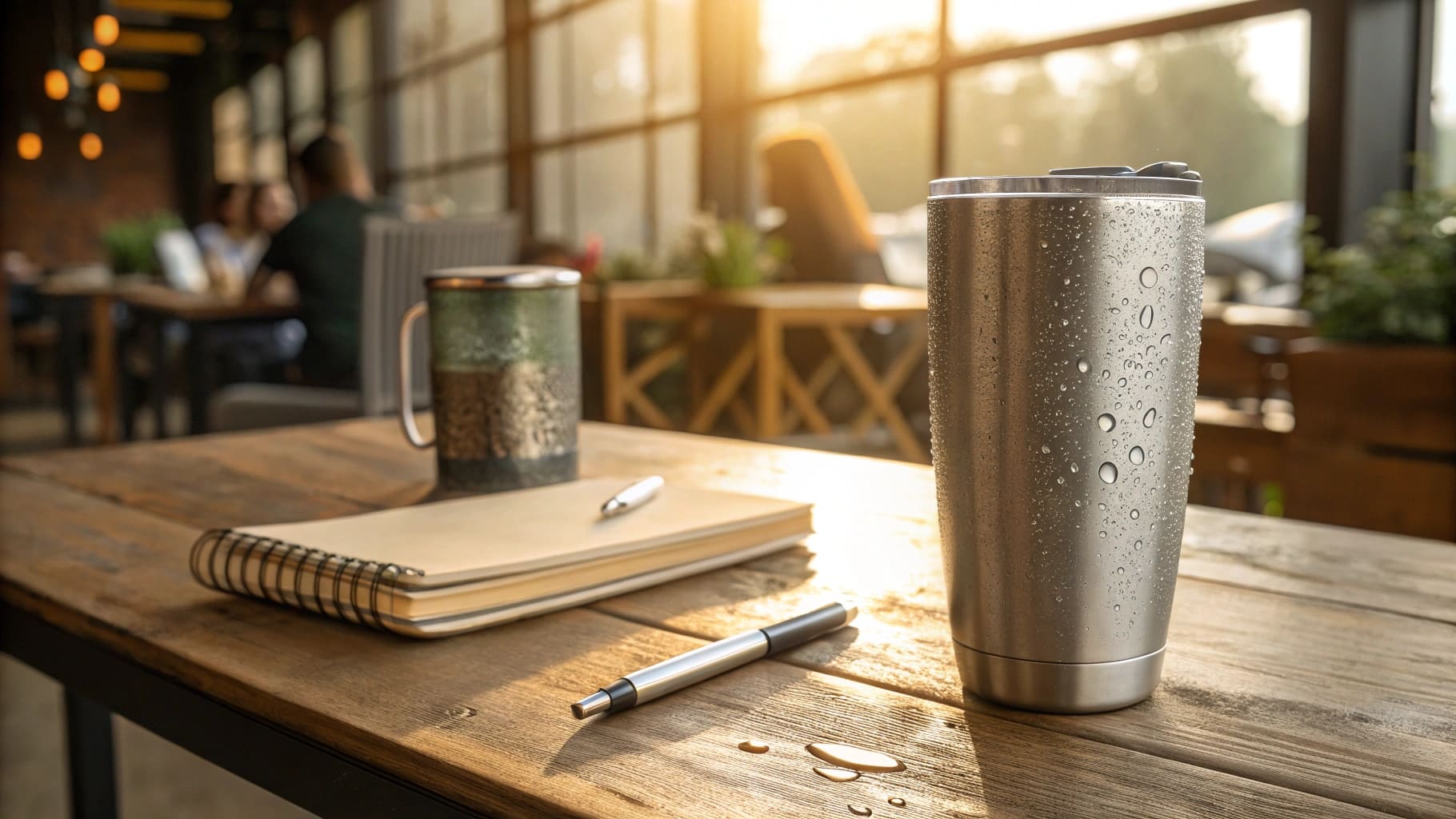Frustrated by thermal claims that don't match reality? This inconsistency can erode your customers' faith. Let's find out the truth about insulation for your brand.
Quality double-walled vacuum-insulated stainless steel bottles usually keep drinks cold for up to 24 hours. The vacuum seal's quality and steel grade, often 304, are key. This performance is crucial for end-user satisfaction and your brand.

You now know the basic cold retention times. But as a smart B2B buyer, you need more details. For procurement officers like Mark Shenng in Canada, or any startup boss, these details matter. Let's explore other important aspects that make stainless steel bottles a great choice for your wholesale business. This is especially true if you are sourcing hip flasks, water bottles, or coffee mugs from China, like we offer at Icobottle.
How long does a stainless steel cup last?
Worried your custom branded cups won't stand the test of time? Poor durability means unhappy customers and hurts your reputation. Let's look at real lifespan.
A well-made stainless steel cup, using quality materials like 304 steel, can last for many years. Its durability comes from rust resistance and not leaching chemicals, especially with good care. This is a major selling point.

As someone like Mark, purchasing stainless steel water bottles from developing countries to rebrand and sell, durability is a top concern. I’ve been in this business with Icobottle for a while, and I’ve seen many buyers focus heavily on the initial price. But the real value is in a product that lasts. A durable cup, hip flask, or coffee mug reflects well on your brand for years. When I talk to clients, I always emphasize that product lifespan is a silent ambassador for their brand. If it lasts, customers remember where they got it.
What Defines Cup Longevity?
The main thing is the material. Most good quality bottles, like the ones we make at Icobottle, use 18/8 or 304-grade stainless steel. This type is great because it resists rust and is very strong. It also doesn’t leave a metal taste in drinks, which your end-users will appreciate. The way the cup is made also matters. Strong welds and good construction make a cup tougher and last longer.
Key Factors for Wholesale Buyers like Mark
When you, Mark, place a big order, you need every single cup to be good quality.
Here’s what you should check:
- Steel Grade Verification: Always ask for proof of the stainless steel grade. Some suppliers might try to use cheaper, lower-quality steel. At Icobottle, I make sure our clients get documents confirming the material for their water bottles and tumblers.
- Manufacturing Checks: Look closely at how the cups are made. Check the welds, the surface finish, and the overall build. Are there any sharp bits? Does the lid fit well? These small things affect how long the product lasts.
- Wall Thickness Consideration: You can't always see it, but a slightly thicker wall can make the bottle stronger. This is good for bottles that people will use outdoors or for sports.
Why Durability Impacts Your Brand
A product that lasts a long time means fewer people will return it or complain. This saves you money and trouble. Even better, it makes customers trust your brand. When someone sees that the water bottle you sold them is still good after years, they think your brand means quality. This is very important for Mark, who rebrands products. His brand's name is on that product. My experience shows that spending a bit more for a better, more durable product from a trustworthy supplier like Icobottle really helps in the long run. Customers will be happier, and they'll keep buying from you.
Here is a simple table to help:
| Factor | Impact on Lifespan | My B2B Advice for Mark |
|---|---|---|
| Stainless Steel Grade1 | Higher grade (e.g., 304) = longer life | Always verify. At Icobottle, we ensure food-grade 304/316 for lasting products. |
| Manufacturing Quality2 | Good welds, proper seals = durability | Inquire about QC. Icobottle has strict QC for every item from flask to mug. |
| Wall Thickness | Thicker walls = more robust | Match to end-use. For rugged applications, a thicker wall can be a selling point. |
| End-User Care | Proper care extends life | Suggest basic care tips. It adds value and shows you care about the product's longevity. |
How long does stainless steel stay hot?
Customers complain their drinks cool too fast in your branded mugs? This erodes product value. Let's see how long quality steel truly keeps drinks hot.
A good double-walled vacuum-insulated stainless steel bottle or mug can keep drinks hot for up to 12 hours. The vacuum insulation quality is the main factor for this performance. This is vital for user satisfaction.

Many customers buy coffee mugs or tumblers expecting them to keep drinks hot. As a B2B buyer, like Mark sourcing for the Canadian market, you must make sure your products deliver on this. A travel mug that keeps coffee warm on a cold morning is a huge selling point. At Icobottle, I always tell my clients that how well a mug keeps heat isn't just a feature; it's a big part of how happy the customer will be. It affects their daily experience with your branded product.
The Secret to Heat Retention
The magic is in the vacuum insulation. Good stainless steel bottles and mugs have two steel walls. There is a vacuum space between these walls. This vacuum greatly slows down heat moving by conduction and convection. So, heat from the hot drink inside can't get out easily. And the cold from outside can't get in easily. The lid design is also very important. A lid that seals well stops heat from escaping from the top. Some lids even have extra insulation.
What Affects Heat Retention in Your Bulk Orders?
When Mark orders many units, he wants them all to work well.
Here are key points for keeping heat:
- Vacuum Integrity: This is the most important. The supplier needs a good way to create and seal the vacuum. A bad vacuum means the drink won't stay hot. At Icobottle, we test every batch to ensure the vacuum is perfect.
- Lid Quality: The lid's material, the quality of its seals (usually silicone), and how it closes all make a difference. A loose lid or one that’s poorly designed will let heat escape quickly. We pay close attention to lid design for our coffee mugs and tumblers.
- Material Thickness: The vacuum is most important, but the thickness and quality of the steel walls can also play a small part in heat retention.
A Buyer's Guide to Checking Heat Retention
It's hard to check every single unit in a big order. But you can ask your supplier for test reports. You can also test some samples yourself. Fill a few sample bottles with hot water at a certain temperature. Then, measure how much the temperature drops over several hours. I often give this data or samples from Icobottle so clients like Mark can be sure. This is important for Mark, especially if he has had problems with suppliers before, like inefficient communication or even certificate issues. Building trust is key.
Here's a quick table:
| Feature | Impact on Heat Retention | My Recommendation for B2B Buyers like Mark |
|---|---|---|
| Vacuum Insulation | Main factor for long retention | Always confirm true vacuum insulation. This is a standard for Icobottle thermal coffee mugs and tumblers. |
| Lid Seal Quality | Poor seal = fast heat loss | Check lid design and seal material. A tight, well-made seal is essential for performance. |
| Pre-heating Bottle | Can improve initial retention | Advise end-users to pre-heat for best results, a small tip that enhances perceived quality. |
| Ambient Temperature | Colder air = faster heat loss | The vacuum should significantly buffer this, but it's a real-world factor to acknowledge. |
Is stainless steel Cold worked?
Unsure about 'cold working' in stainless steel manufacturing? This technical detail can impact bottle strength and durability, affecting your product choice. Let's clarify its importance.
Yes, stainless steel for bottles is often cold worked. This process strengthens the steel and improves its surface finish. It contributes to the bottle's overall durability and structural integrity without using heat.

For B2B buyers like Mark, who might not be a technical expert but is very sensitive to quality, understanding terms like "cold worked" can be helpful. It's a manufacturing process that makes a difference in the final product, like the stainless steel water bottles or hip flasks you might be sourcing from China. At Icobottle, we know that the way steel is treated affects its properties. While "cold working" is a specific term, the principle of strengthening steel through manufacturing is something we focus on.
What is Cold Working?
Simply put, cold working means shaping metal at a temperature below its recrystallization point. Usually, this is done at room temperature. When stainless steel is cold worked, its internal crystal structure changes. This change makes the steel harder and stronger. It also often improves the smoothness of the metal's surface. This process doesn't involve high heat like hot working.
Why Cold Working Matters for Your Stainless Steel Products
Understanding this helps you appreciate certain quality aspects:
- Increased Strength: Cold-worked steel is stronger. This means bottles made from it are more resistant to dents and getting bent out of shape. This is very important for products like water bottles that people might drop or knock around.
- Better Durability: Because the steel is stronger, the product generally lasts longer. This is a big plus for Mark, who wants to offer his Canadian customers products that stand up to use. It means the investment in quality pays off.
- Improved Surface Finish: Cold working can make the steel surface smoother and more consistent. This is good for looks. It also provides a better base for customizations like printing logos or applying special colors, which Icobottle offers.
What to Ask Your Supplier
Mark might not need to specifically ask "Is this steel cold worked?". But he can ask about the steel's tensile strength or the manufacturing methods used to ensure durability. When I talk with clients at Icobottle, I explain our focus on robust construction and high-quality materials. These practices often give benefits similar to cold working, ensuring the final hip flasks, tumblers, and cups are top-quality. For Mark, knowing that his supplier focuses on these strengthening processes provides another layer of confidence, especially given his past pain points with supplier communication and product quality.
Here’s how cold working benefits your products:
| Aspect of Cold Working | Benefit for Stainless Steel Bottles | Why It's Important for Mark's Business |
|---|---|---|
| Strengthening | Increased resistance to dents, deformation | Enhances product robustness, crucial for items like water bottles used actively. |
| Durability | Longer product lifespan | Supports brand reputation for quality and longevity in the Canadian market. |
| Surface Finish | Smoother, more uniform surface | Improves aesthetics and is better for customization like logo application on tumblers. |
| Process Control | Indicates advanced manufacturing | Suggests a supplier (like Icobottle) with good control over material properties. |
Conclusion
In short, quality stainless steel bottles offer great thermal performance and lasting durability. Focus on material, vacuum, and manufacturing to ensure your branded products truly satisfy your customers.

